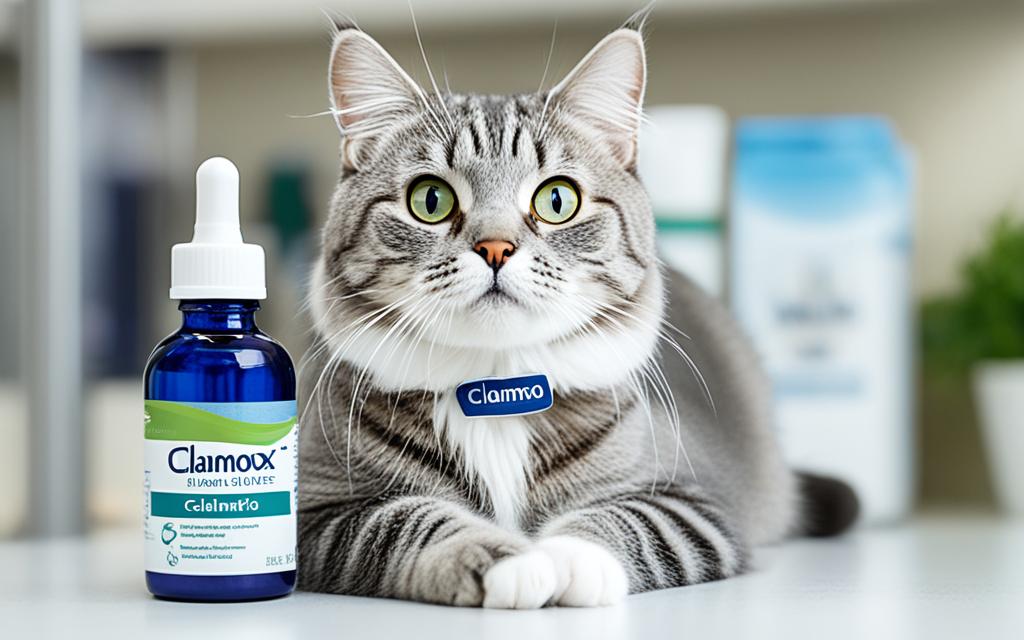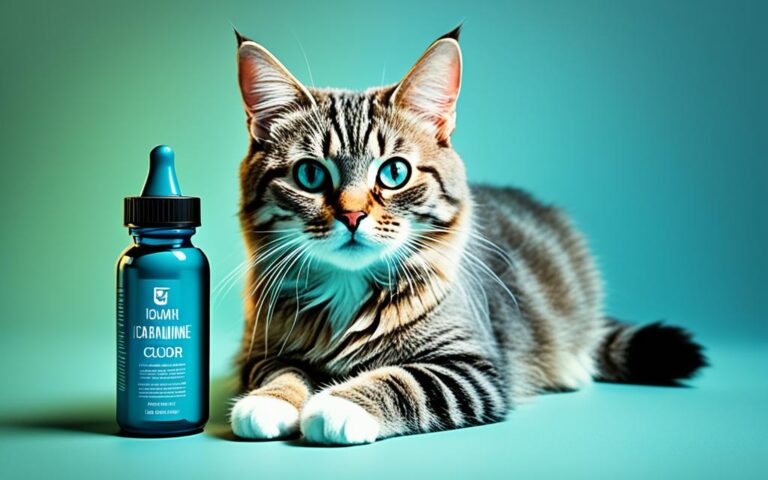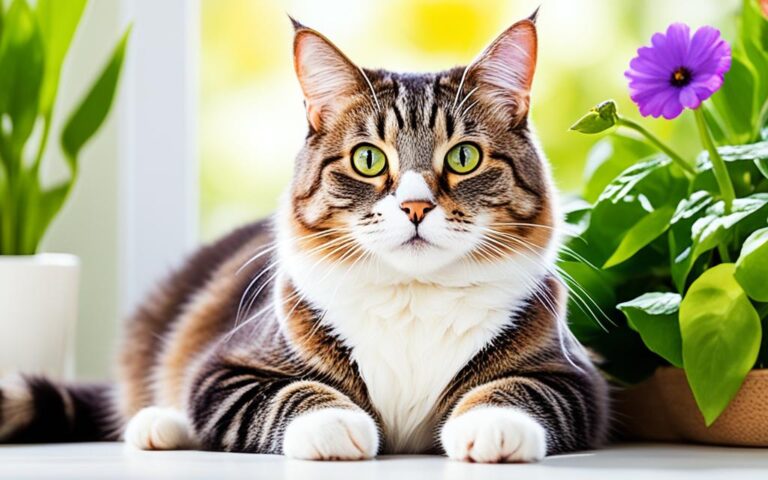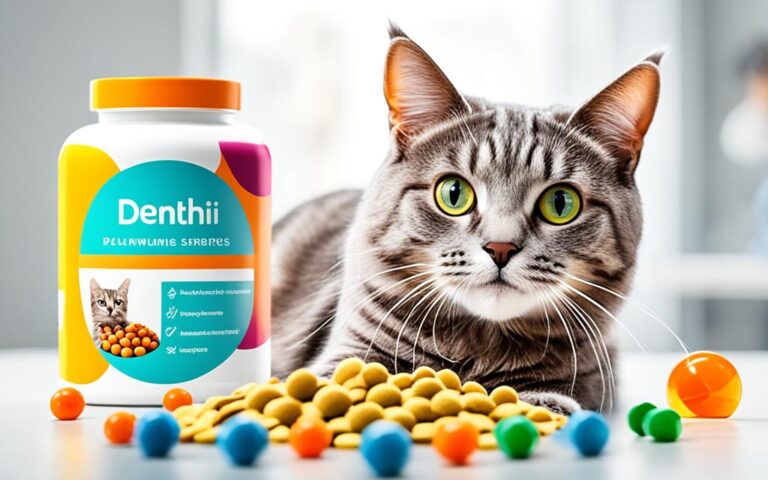Clavamox® for cats : Antibiotic Uses & Side Effects Guide
Clavamox® is a well-known antibiotic for pets. It treats bacterial infections in cats and dogs like urinary, respiratory, and skin issues1. This antibiotic is also given to birds and ferrets for certain infections1. Since Clavamox® is prescription-only, the dosage and side effects vary. Understanding its correct use and risks is important for pet owners1.
Key Takeaways
- Clavamox® is a combination antibiotic commonly used to treat various infections in cats and dogs.
- The antibiotic components of Clavamox® work together to prevent bacteria from producing key cell wall components, helping to kill the bacteria.
- Common side effects of Clavamox® in pets include stomach upset, vomiting, diarrhea, and lack of appetite.
- Clavamox® should not be used in rabbits or herbivores as it can lead to life-threatening diarrhea.
- Clavamox® typically starts working within a few hours, but noticeable improvement may take up to five days.
Table of Contents
What is Clavamox®?
Clavamox® is a powerful antibiotic with two main elements: amoxicillin and clavulanic acid2. Amoxicillin fights bacteria by stopping them from making a crucial part of their cell wall2. This makes the bacteria unable to survive. On the other hand, clavulanic acid blocks an enzyme that could harm amoxicillin, making it more effective2. Together, these partners in Clavamox® take on a wider variety of bacterial invaders than amoxicillin by itself.
Understanding the Composition
Clavamox® teams up amoxicillin and clavulanic acid, a potent duo against bacterial infections2. Amoxicillin, a common antibiotic, and clavulanic acid, a key supporter, help each other out3. This team effort allows Clavamox® to tackle different bacterial foes in pets.
Mode of Action
Clavamox® fights bacteria by blocking crucial enzymes they need to survive, leading to their demise2. It also stops bacteria from using a trick to avoid amoxicillin, making Clavamox® more effective2. This blended approach gives Clavamox® a wider reach in fighting off bacteria, more than what amoxicillin alone could do.
“Clavamox® is the veterinary equivalent of Augmentin for humans, combining amoxicillin and clavulanic acid to treat a wider range of bacterial infections.”4
Common Uses of Clavamox® in Cats
Clavamox® is a mix of two drugs: amoxicillin and clavulanic acid. It’s a key antibiotic in helping our feline friends fight infections. This drug is widely used in pets to tackle infections, specifically in the skin, soft tissues, and even gum diseases5.
It also aids in fighting off urinary infections, proving its worth in the vet’s toolkit. This shows just how handy Clavamox® is in the world of pet medicine5.
This special mix is very good at fighting off tough bacteria that other drugs can’t handle6. Vets often turn to Clavamox® for many infections, such as those in the skin, urine, and mouth. It’s used for respiratory, dental, bone, and wound infections too6.
- Skin infections, such as abscesses, infected wounds, and hot spots
- Soft tissue infections, including bite wounds and cellulitis
- Periodontal (gum) disease and related dental infections
- Urinary tract infections
- Respiratory infections, including pneumonia and bronchitis

“Clavamox® is a valuable tool in the veterinarian’s arsenal for treating a wide range of bacterial infections in cats. Its broad-spectrum capabilities and potency against resistant strains make it a go-to choice for many feline health issues.”
Knowing about Clavamox® helps cat owners partner better with their vets. This ensures their beloved cats get the right antibiotic care for various health issues567.
Administering Clavamox® to Cats
Dosage and Frequency
The prescribed amount of Clavamox® for a cat is 62.5 mg (1 mL) twice a day8910. Vets usually give this for skin and soft tissue infections. The cat should take it for 5-7 days. Or for 48 hours after symptoms stop, but not more than 30 days910. For UTIs, they might take it 10-14 days or longer910.
Clavamox® comes as a liquid or tablet. The vet picks the right one for your cat10. The liquid has 50 mg of amoxicillin and 12.5 mg of clavulanic acid in each milliliter. Always use it within 10 days after mixing9.
Missed Dose Guidelines
Forget a dose? Call your vet for advice. They might say to give it as soon as you remember, but not if it’s almost time for the next dose8. In that case, they might tell you to just wait for the next dose8. Don’t give more to catch up missed doses8.
Using Clavamox® correctly is key. Stick to the vet’s plan for the best results8910. The right use helps your cat get better and keeps antibiotics working well8910.
“Careful administration of Clavamox® is crucial for the successful treatment of your cat’s condition.”
Potential Side Effects and Precautions
When giving your cat Clavamox®, you should know about the possible side effects. The main ones are upset stomach issues like vomiting, diarrhea, and loss of appetite11. These happen because Clavamox® can disturb the good bacteria in a cat’s gut, causing tummy troubles11. To reduce these problems, always feed your cat before giving Clavamox®11.
Adverse Reactions in Cats
Some cats may have rare allergic reactions to Clavamox®. Signs of this include hives, rashes, fever, and changes in blood cell numbers11. Though not often, severe effects like refusing to eat and liver issues can happen12. Pet owners need to watch their cats closely. If they see any strange signs, they must call the vet right away.
It’s also essential to avoid using Clavamox® in cats that are allergic to it or similar medicines like penicillins12. Be careful when giving Clavamox® to rabbits and certain other small animals. It could harm their stomachs, even fatally12.

Always stick to what your vet tells you about Clavamox®’s dose and treatment time. This medicine should help your pet feel better in 1 to 2 days but lasts only a short while11. Good care and watching over your pet are vital for using Clavamox® safely and effectively.
Clavamox® for cats : Antibiotic Uses & Side Effects Guide
Clavamox® combines amoxicillin and clavulanic acid. Vets often use it to treat bacterial infections in cats13. It’s been a trusted antibiotic in animal medicine for more than 40 years. This is because it works against many types of bacteria, even ones that resist other drugs13.
It stops bacteria from making their cell walls. This makes them unable to multiply8. Adding clavulanic acid makes it even more powerful. It prevents some bacteria from deactivating the amoxicillin8.
Common Uses of Clavamox® in Cats
Clavamox® treats various infections in cats. These include issues with the skin, respiratory system, urine, and gums8. It’s great for fighting Staphylococcus, Streptococcus, and other common bacteria in cats8.
Administering Clavamox® to Cats
The usual dose for cats is 62.5 mg (1 mL) twice daily. Treatment time depends on the infection8. It’s key to follow the vet’s advice and finish the medication, even if your cat seems better1.
Potential Side Effects and Precautions
Cats might have mild side effects to Clavamox®, like upset stomach. These usually go away when the medication ends1.
Never give Clavamox® to rabbits or herbivores. It can cause severe diarrhea. Also, tell your vet about all the medications your cat takes1.
Using Clavamox® the right way can help your cat fight off infections. Always work with your vet. Knowing about this drug helps pet owners and vets together take the best care of your cat1381.
Comparison to Similar Antibiotics
Clavamox® is a common choice for treating bacterial infections in cats. It’s like Augmentin, which people use, but they’re not the same. The main difference is how they’re dosed. Clavamox® shows both its chemicals, amoxicillin and clavulanate, but Augmentin usually only lists amoxicillin. This means their doses and costs can vary a lot.
Efficacy and Cost Considerations
Clavamox® is made just for pets, giving it some benefits over forms for humans14. It’s known to be safe and works well for cat infections. It’s also better absorbed by cats than some other similar antibiotics14. Pet owners like it because they can choose drops or chewable tablets based on their cat’s needs.
Thinking about using a different form, like generic amoxicillin-clavulanate, can be smart. This is especially so when Clavamox® Drops are not available, as seen when they were on backorder until mid-201915. Even with these situations, Clavamox® is still a solid pick for fighting many cat infections in a cost-effective way1416.
| Antibiotic | Efficacy | Cost |
|---|---|---|
| Clavamox® | Proven effective for skin infections, better absorption in cats | Comparable to generic alternatives |
| Amoxicillin-Clavulanate (Generic) | Effective for a variety of bacterial infections | May be slightly lower cost than Clavamox® |
| Augmentin (Human Formulation) | Effective for a variety of bacterial infections | Typically more expensive than Clavamox® or generic alternatives |
Overall, when it comes to treating cat infections, Clavamox® stands strong. It’s designed with pets in mind and offers benefits in dosing, absorption, and availability151416.
“Clavamox® is a practical and effective choice for treating a wide range of bacterial infections in cats.”
Drug Interactions and Contraindications
Clavamox® is a popular antibiotic for cats but might interact with other drugs. Always tell your vet about all the medicines your cat is using before starting Clavamox®17. Don’t give Clavamox® at the same time as some antibiotics. These include tetracycline and chloramphenicol because they could make Clavamox® less effective18.
Clavamox® isn’t usually good for small pets like ferrets, rabbits, and guinea pigs. It could even lead to severe diarrhea in these animals17. For pregnant or breeding cats, the use of Clavamox® is still debated. Vets decide on its use after weighing the risks and benefits18.
Make sure to follow your vet’s Clavamox® instructions closely. Also, inform your vet about any other medicine or supplement your cat is on19. Good communication and care are key for safe and beneficial use of this antibiotic.
“Clavamox can interact with certain antibiotics, and it’s not recommended for small animals like ferrets or rabbits. It’s important to talk to your vet about any other medications your cat is taking.”
Storage and Handling
Storing and handling Clavamox® right is key to keeping it effective and safe20. Clavamox® chewable tablets and powders should stay under 77°F (25°C)21. If you mix it, keep the oral suspension in the fridge and don’t use it after 10 days21. Always close the container to protect it from moisture and light.
Clavamox® must be stored correctly to stay good and work well21. Keep drops at 15-25°C before using21. Make sure it’s where kids and pets can’t get to it for safety20. Check the label for precise storage directions to keep it strong and working20.
| Clavamox® Formulation | Storage Conditions | Shelf Life |
|---|---|---|
| Chewable Tablets | Below 77°F (25°C) | Refer to label |
| Powder for Reconstitution | Below 77°F (25°C) | Refer to label |
| Oral Suspension (after reconstitution) | Refrigerate | 10 days |
| Drops (unreconstituted) | 15-25°C (59-77°F) | Refer to label |
Conclusion
Clavamox® is a known antibiotic mix for cats, fighting many bacterial infections effectively22. It’s great for issues like UTIs, skin infections, and breathing problems in cats22.
To make sure Clavamox® helps your cat, it’s key to know the correct dose, watch for side effects, and store it right23. Listening to your vet and noticing how your cat reacts is important. This helps your cat get better and stay healthy22.
Using Clavamox® means pet owners and vets should work together24. They can make sure the cat’s bacterial infections are treated well without harming the cat’s health. They should also think about how the medicine might affect the cat’s gut and overall well-being24.
FAQ
What is Clavamox®?
How does Clavamox® work?
What are the common uses of Clavamox® in cats?
What is the dosage of Clavamox® for cats?
What should I do if I miss a dose of Clavamox® for my cat?
What are the potential side effects of Clavamox® in cats?
How does Clavamox® compare to similar antibiotics?
Are there any interactions or contraindications with Clavamox®?
How should Clavamox® be stored?
Source Links
- Clavamox® for Dogs and Cats
- Clavamox
- Clavamox For Dogs: Safe Dosages And Uses
- No title found
- Amoxicillin-Clavulanic Acid | VCA Animal Hospitals
- How Clavamox® Treats Bacterial Infections in Dogs & Cats
- Was your cat prescribed Clavamox? Here’s what you should know
- CLAVAMOX® Drops
- Clavamox Oral Suspension For Dogs and Cats I Amoxicillin and Clavulanate Potassium Antibiotic Suspension I Medi-Vet
- Clavamox for Cats: Uses, Doses, & Side Effects (Vet Answer) – Catster
- Amoxicillin | VCA Animal Hospitals
- Clavamox for Dogs: Uses, Dosing, Side Effects | Great Pet Care
- 1800PetMeds
- Just Ask the Expert: An alternative to Clavamox Drops?
- 1800PetMeds
- Clavamox Chewable Tablets for Animal Use – Drugs.com
- Amoxicillin-clavulanic acid (Clavamox, Augmentin, Clavacillin)
- Clavamox Drops for Animal Use – Drugs.com
- Clavamox Drops for Animal Use (Canada) – Drugs.com
- Understanding Clavamox: What You Need to Know
- Amoxicillin for Cats: Dosage, Safety & Side Effects – Cats.com
- Short- and long-term effects of amoxicillin/clavulanic acid or doxycycline on the gastrointestinal microbiome of growing cats







